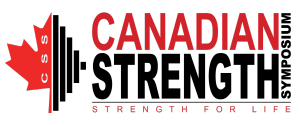Are You Strong Enough for Life?
Today’s guest post is from Dr. Scotty Butcher, PhD, PT, an assistant professor at the University of Saskatchewan’s department of physical therapy, and the chair of the Canadian Strength Symposium happening in Saskatoon, SK, January 23-25. I’ll be a presenter there, alongside Dr. Stuart McGill, Andre Benoit, and a bunch of other big names, as well as a strongman and powerlifting competition.
Click HERE for more info on the Canadian Strength Symposium
“The old that is strong does not wither” – J.R.R. Tolkien
I’m pretty much a dwarf. Just call me Gimli. I’m not just talking about physical size, although that’s true too, but about the size of my lifts compared with other powerlifters. To be fair, though, I’m already past the Mountain of Khazad-dûm on my quest for Mordor (ie. I’m just on the wrong side of 40) and I only begun my quest a couple of years ago. (Ok, ok, enough with the LOTR references….. for now.)
Nevertheless, my four wheel deadlift truly is dwarfed by the wizards in the powerlifting world. Does that mean I’m not strong? Compared with the average population a competition best of 407lbs after two years of training is very strong. And certainly compared with some physical therapy peers and students who I’ve heard ask, ‘why would anyone ever want to lift weights that heavy when they don’t need to in daily life?’, that’s unthinkable. It’s true – I live in two worlds; one where I battle to get stronger, and the other where I battle to teach the power of strength. So, the question often asked is, “am I and are you strong enough?” What is strong enough for life? Thanks to Dean Somerset for allowing me to answer this question on his blog.
First, I think that’s the wrong question. A better question, in my opinion, is, “are you getting stronger?” Strength deficiencies have really reached epidemic proportions in our society to the detriment of our health and function. Everyone can benefit from either getting stronger or improving the expression of their strength. Regardless, there are many strength standards published in the literature and popular media. For example, depending on the source, my four plate deadlift would classify me as any of strong (but not very), good, novice, intermediate, advanced, or weak.
If I had to pick one standard that is applicable for anyone, it is that of Dr. Lon Kilgore from his excellent book, FIT. The standards can be found here. Incidentally, for those interest in Dr. Kilgore’s work, he will be coming to Saskatoon, Canada January 23-25, 2015 for the Canadian Strength Symposium. Also, not the least of the reasons to be there, Dean will also be there speaking about strength training in rehabilitation. You don’t want to miss this!
Getting back to standards, the reason I like Dr. Kilgore’s standards are that they place me where a good dwarf should be: somewhere between intermediate and advanced…. kidding. The real reason is that they are applicable for anyone at any stage of training. No one wants to start training and hear that after years of training, they are still weak. A metric that allows for good progression is way more palatable. The problem, still, is so what? Yeah, your client has progressed from untrained to novice, but what does that mean? How will it impact their life?
In light of the Canadian Strength Symposium’s theme, Strength For Life, I’ll answer the question looking at the impact of strength ON life. Mortality, function, and disease, to be specific. It is well known that one of the greatest predictors of physical function as we get older is strength [1-3]. What is less known is that muscle strength can have a significant impact on disease prevention and even mortality. A series of recent articles have examined the impact of strength levels on mortality in healthy older men [4], patients with hypertension [5], and with lung disease [6]. All of these studies found that mortality was reduced in those individuals with the highest level of strength, even when controlling for other factors such as fitness. Also, the higher the muscle strength, the less likely the client will be to develop metabolic disease [7].
So, stronger is good for life, but what is the level of strength at confers these benefits? An interesting aspect of some of these studies was to classify the level of strength required to achieve the lowest risk of death or disease. For men, a bench press of between 0.9 and 1.3kg per kg of body mass and a leg press of between 1.8 and 2.0 per kg achieved the lowest risk. So a 180 lb man would need to bench up to 234lbs and leg press up to 360lbs. Unfortunately, this type of data is not available for women at present.
These aren’t big numbers from the perspective of a young healthy trainee, but they are very high for a life-long sedentary client. The good news, as we know, is that with a good quality training program, they are very attainable. The even better news, as we know as well, is that once your clients catch the training bug, these standards will fly by and they’ll want more – with even greater benefit to your clients’ physical function.
So, my answer to the question, “are you strong enough?” will always be “I am getting stronger.” Maybe someday, I’ll be more like Gandalf and less like Gimli.
Dr. Scotty Butcher, PhD, PT
Dr. Scotty Butcher is an Assistant Professor in Physical Therapy at the University of Saskatchewan and Co-Owner of BOSS Strength Institute. He is a physical therapist who also holds a PhD in Exercise Physiology and Experimental Medicine, a Certified Strength and Conditioning Specialist (NSCA), and a Registered Clinical Exercise Physiologist (ACSM). Dr. Butcher’s over fifteen years of professional experience as a physical therapist range from work with elite athletics to chronic disease rehabilitation with the common theme of exercise prescription. Scotty teaches exercise physiology and rehabilitation to physical therapy students and conducts research in the area of strength training and high-intensity exercise testing and prescription.
References:
- Buchman, AS, Wilson, RS, Boyle, PA, Tang, Y, Fleischman, DA, & Bennett, DA. Physical activity and leg strength predict decline in mobility performance in older persons. J Am Geriatr Soc. 2007; 55(10): 1618-1623.
- Butcher SJ, Pikaluk BJ, Chura RL, Walkner MJ, Farthing JP, Marciniuk DD. Associations between Isokinetic Muscle Strength, High-Level Functional Performance, and Physiological Parameters in Patients with Chronic Obstructive Pulmonary Disease. International Journal of COPD. 2012; 7:537-542.
- Puthoff, ML, & Neilsen, DH. Relationships among impairments in lower-extremity strength and power, functional limitations, and disability in older adults. Phys Ther. 2007; 87(10): 1334-1347.
- Ruiz, JR, Sui, X, Lobelo, F, Morrow, JR, Jackson, AW, Sjöström, M, & Blair, SN. Association between muscular strength and mortality in men: Prospective cohort study. BMJ. 2008; 337: a439.
- Artero, EG, Lee, D, Ruiz, JR, Sui, X, Ortega, FB, Church, TS, Lavie, CJ, Castillo, MJ, & Blair, SN. A prospective study on muscular strength and all-cause mortality in men with hypertension. J Am Coll Cardiol. 2011; 57(18): 1831-1837. doi:10.1016/j.jacc.2010.12.025
- Swallow EB, Reyes D, Hopkinson NS, Man WDC, Porcher R, Cetti EJ, Moore AJ, Moxham J, Polkey MI. Quadriceps strength predicts mortality in patients with moderate to severe chronic obstructive pulmonary disease. Thorax. 2007:62:115-120.
- Senechal M, McGavock JM, Church TS, Lee DC, Earnest CP, Sui X, Blair SN. Cut points of muscle strength associated with metabolic syndrome in men. Med Sci Sports Exerc. 2014;46:1475-81.




One Response to Are You Strong Enough for Life?